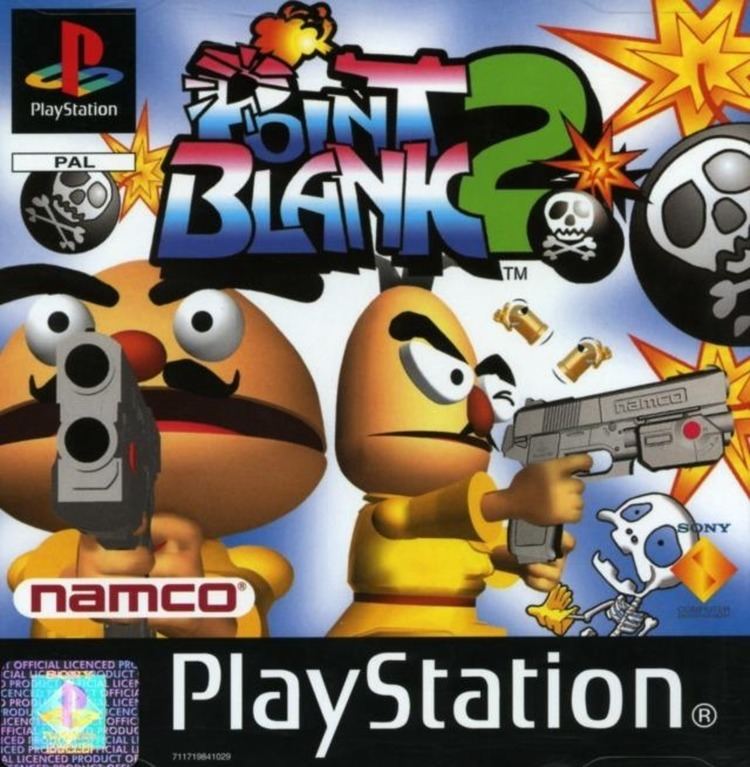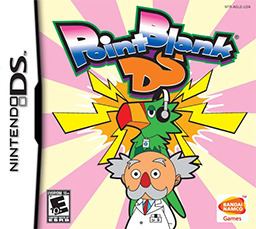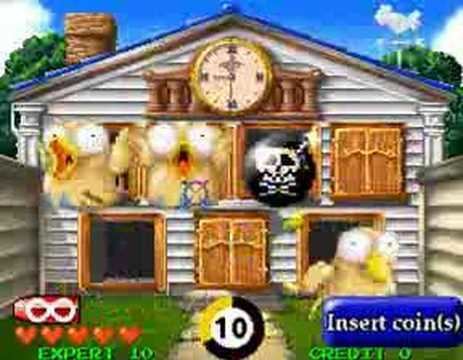Developer(s) Namco | Genre(s) First-person shooter | |
 | ||
Publisher(s) Arcade
Namco
PlayStation
JP: Namco
EU: SCEE
Nintendo DS
JP: Namco
NA: Namco Bandai Games
EU: Atari Corporation Platform(s) Arcade, PlayStation, PlayStation 2, Nintendo DS, iOS, Android Release Arcade
JP: October 1994
NA: 1994
PlayStation
JP: August 7, 1997
NA: April 30, 1998
EU: July 1998
Nintendo DS
JP: May 18, 2006
NA: June 14, 2006
EU: July 8, 2006
AU: July 15, 2006 Mode(s) Single player, Co-Op Multiplayer Games Point Blank DS, Point Blank 3, Ghoul Panic, Point Blank, Point Blank 2 | ||
Point Blank, known as Gun Bullet (ガンバレット, Gan Baretto), or Gunvari (ガンバリ, Ganbari) in Japan, is a series of First-person shooter games developed by Namco for the arcade, PlayStation and Nintendo DS; the trilogy was first released in arcade in 1994 and was later ported onto the PlayStation. Point Blank DS was released in 2006 for the Nintendo DS featuring 40 challenges from the original series - and the original Point Blank was the sixth lightgun game released by Namco, after both Golly! Ghost!s and Steel Gunners (1990–91) and Lucky & Wild (1992), the last one requiring the first player to drive as well as operate the lightgun.
Contents

Gameplay

Players use two attached light guns (in the case of the DS, a pen or in the case of the iOS version, touching the screen) to hit targets onscreen; missions require speed, quick judgment or pinpoint accuracy. The game consists of non-violent, all-ages, shooting contests like shooting targets (and avoiding bombs and civilians much like in both Steel Gunners), shooting cardboard targets, shooting targets of the players' colors, protecting the iconic Dr. Don and Dr. Dan, and other miscellaneous challenges, similar to games like Police Trainer, and Area 51: Site 4 - and players choose the desired difficulty level (Practice, Beginner, Advanced, and Very Hard in the first game, or Training, Beginner, Advanced, and Insane in the second game) which will determine how many stages must be finished to complete the game, as well as their overall difficulty. Players are shown four missions in each grouping, and may attempt them in any order; they usually have only three lives for the entire game, but this may depend on the cabinet settings. Most stages have unlimited bullets, but some have a limited amount of ammo. Players can lose lives by failing to complete a quota in the time limit, shooting bombs, letting Dr. Don (and/or Dr. Dan) die in any mission where they must protect them, incorrectly answering questions by shooting the wrong answers, shooting cardboard civilians or geisha girls, shooting their opponent's targets, having less points after completing a stage, failing to complete a quota (and any one-life penalty that loses multiple lives), letting meteors destroy the Earth, running out of bullets in some stages, shooting incorrect differences, letting aliens steal slots, and many other ways (not shown here).

There are six different types of stages in the game: Accuracy, where both players must shoot the designated areas with the highest points, Intelligence, where they must count to sixteen (by shooting the numbers), Memory, where they must match two cards by shooting two matching cards, Simulation, where they are required to shoot the cardboard robbers but not civilians (in the Japanese theme of this type, they must shoot cardboard ninjas, but not geishas), Visual Acuity, where they are required to shoot the target which matches what is displayed, and Speed, where they are required to shoot targets of their designated colors (depending players play from left or right); in the arcade version, both light guns must also be calibrated before the crosshairs on the screen shall move.
Games

Development
Point Blank was originally developed as an arcade game in 1994, but a console version was later made for the PlayStation in 1997; this version included an "arrange" mode which added an alternate version of Arcade mode, as well as adding many new gameplay modes alongside an RPG mode. The game was re-created in 1999 as Point Blank 2, adding more mini-stages and replacing "Very Hard" difficulty with "Insane" - and the game was once again re-created in 2001 as Point Blank 3 but was only released for the arcades in Japan and the PlayStation worldwide, and featured a cameo from Rick Taylor from Splatterhouse.
At the 2006 Game Developers Conference, in San Jose, CA, a Nintendo DS port of the game was announced; the console's stylus and touch screen is used in place of the light gun. The finished game was released in North America on June 13, 2006, two days after the North American release of the Nintendo DS Lite.
Reception
Official U.S. PlayStation Magazine referred to characters Dr. Dan and Dr. Don as "an underrated dynamic duo" in September 2004.
